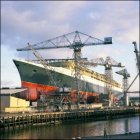A new Cunard liner
A replacement for both the Queen Mary and the Queen Elizabeth, the premier transatlantic liners of the mid twentieth century, operated by Cunard, the world famous name in shipping, was discussed from late 1950s. The decision was of such national importance that a special committee began to advise the UK Government in early 1960. Its report stated that the cost of a replacement - a traditional steamship (no atomic power) with a tonnage of 75,000 gross registered tonnage (grt) and berths for 2,270 passengers - would be in the region of GBP 30 million and that Government should give a loan of GBP 18 million.
The Press nicknamed the project Q3 and soon it was announced that British shipbuilders were to be asked to tender for the construction of the new ship. On December 15 1960 Sir John Brocklebank, chairman of Cunard, held first meeting with representatives of 6 possible builders for Q3. A major anti-climax came in October 1961 when Cunard announced that their plans had been put on ice.
Cunard re-considered the type of ship most suited to the changed operating conditions on the North Atlantic, where the aeroplane had replaced the ship as the “ferry service”, as a cheaper and quicker option. As Sir John Brocklebank, announced in 1962, “She must be a top flight cruise ship… with a concept in advance of any existing ship”.
They decided on a smaller ship of 57,000 grt, one able to sail through the Panama Canal and cruise to and from ports on both sides of the United States. On 19 August 1964 invitations to tender were issued to five UK shipbuilders, three of whom made offers to build the ship Q4.
When the tenders were opened on 30 November 1964, the lowest bid at GBP 25,427,000 and the one with the earliest delivery date of May 1968 was that of John Brown & Company (Clydebank) Ltd, Scotland. The London based board of John Brown & Company (Clydebank) Ltd had decided that due to the prestige of the contract the company would cover the full costs of the project but not include any profit. Cunard had only put GBP 22 million aside for the ship and so they asked John Brown to reduce their costs by GBP 2 million or the contract could not go ahead. After a great deal of work cutting costs the contract for Q4 was signed on 20 December 1964 to much celebration by the workforce.


